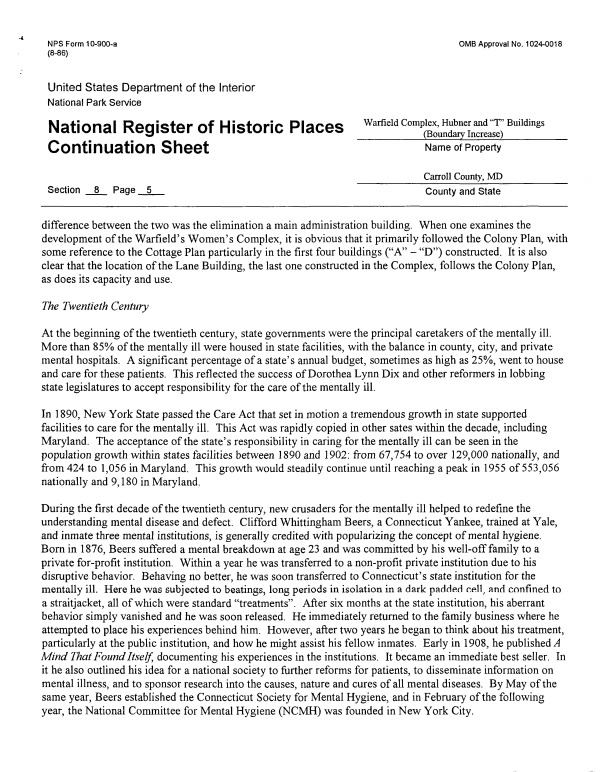 |
||||
|
DEPARTMENT OF HOUSING AND COMMUNITY DEVELOPMENT, MARYLAND HISTORICAL TRUST (Historic Sites Survey) var.d. MSA SE16-7 Image No: se16-7-0318 Enlarge and print image (81K) |
 |
||||
|
DEPARTMENT OF HOUSING AND COMMUNITY DEVELOPMENT, MARYLAND HISTORICAL TRUST (Historic Sites Survey) var.d. MSA SE16-7 Image No: se16-7-0318 Enlarge and print image (81K) |
| NFS Form 10-900-a OMB Approval No. 1024-0018 (8-86) United States Department of the Interior National Park Service Warfkld Comp Buildings National Register of Historic Places __________ Continuation Sheet Name of Property Carroll County, MD Section 8 Page __5__ County and State difference between the two was the elimination a main administration building. When one examines the development of the Warfield's Women's Complex, it is obvious that it primarily followed the Colony Plan, with some reference to the Cottage Plan particularly in the first four buildings ("A" - "D") constructed. It is also clear that the location of the Lane Building, the last one constructed in the Complex, follows the Colony Plan, as does its capacity and use. The Twentieth Century At the beginning of the twentieth century, state governments were the principal caretakers of the mentally ill. More than 85% of the mentally ill were housed in state facilities, with the balance in county, city, and private mental hospitals. A significant percentage of a state's annual budget, sometimes as high as 25%, went to house and care for these patients. This reflected the success of Dorothea Lynn Dix and other reformers in lobbing state legislatures to accept responsibility for the care of the mentally ill. In 1890, New York State passed the Care Act that set in motion a tremendous growth in state supported facilities to care for the mentally ill. This Act was rapidly copied in other sates within the decade, including Maryland. The acceptance of the state's responsibility in caring for the mentally ill can be seen in the population growth within states facilities between 1890 and 1902: from 67,754 to over 129,000 nationally, and from 424 to 1,056 in Maryland. This growth would steadily continue until reaching a peak in 1955 of 553,056 nationally and 9,180 in Maryland. During the first decade of the twentieth century, new crusaders for the mentally ill helped to redefine the understanding mental disease and defect. Clifford Whittingham Beers, a Connecticut Yankee, trained at Yale, and inmate three mental institutions, is generally credited with popularizing the concept of mental hygiene. Born in 1876, Beers suffered a mental breakdown at age 23 and was committed by his well-off family to a private for-profit institution. Within a year he was transferred to a non-profit private institution due to his disruptive behavior. Behaving no better, he was soon transferred to Connecticut's state institution for the mentally ill. Here he was subjected to beatings, long periods in isolation in a dark padded cell, and confined to a straitjacket, all of which were standard "treatments". After six months at the state institution, his aberrant behavior simply vanished and he was soon released. He immediately returned to the family business where he attempted to place his experiences behind him. However, after two years he began to think about his treatment, particularly at the public institution, and how he might assist his fellow inmates. Early in 1908, he published A Mind That Found Itself , documenting his experiences in the institutions. It became an immediate best seller. In it he also outlined his idea for a national society to further reforms for patients, to disseminate information on mental illness, and to sponsor research into the causes, nature and cures of all mental diseases. By May of the same year, Beers established the Connecticut Society for Mental Hygiene, and in February of the following year, the National Committee for Mental Hygiene (NCMH) was founded in New York City. |